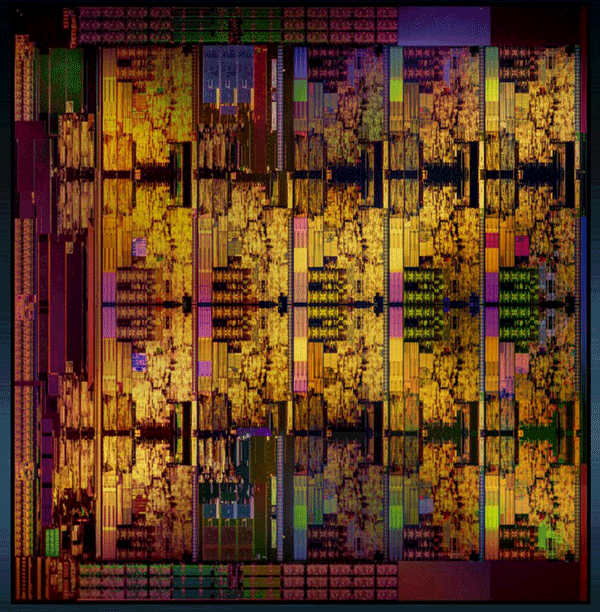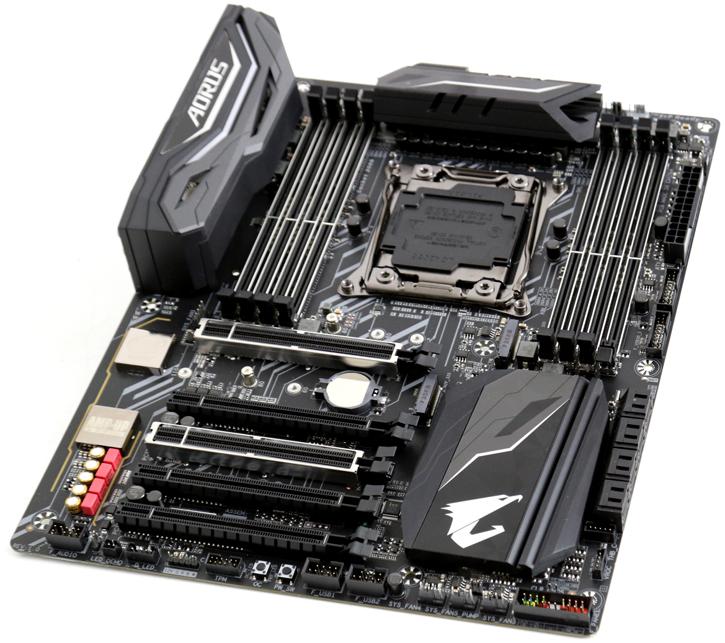Kaby Lake-X and Skylake-X processors
Core i9 and Core X series processors
Intel has announced Kaby Lake-X and Skylake-X processors. Where the previous and current Broadwell-E platform had up-to 10 core processors (Core i7 6950X), Intel will expand on that with an up-to 18-core and thus 36-threads processor. Intel markets the new series as the Core X series, and is also adding a new denominator, the Core i9 series. The new processors are paired with a new chipset, X299 and socket LGA2066.
|
A die-shot of the 18-core Skylake-X series processor |
||||
|
Kaby Lake |
Broadwell-E |
Kaby Lake-X |
Skylake-X |
|
|
CPU cores |
4 |
6, 8, 10 |
4 |
6, 8, 10, 12, 14, 16 |
|
Cache |
8MB |
Up to 25MB |
8MB |
13.75MB |
|
PCIe support |
PCIe 3.0 (16 lanes) |
PCIe 3.0 (40/28 lanes) |
PCIe 3.0 (16 lanes) |
PCIe 3.0 (44/28 lanes) |
|
Integrated graphics |
Yes |
No |
No |
No |
|
TDP |
95W |
140W |
112W |
140W |
|
Socket |
LGA 1151 |
LGA 2011-v3 |
LGA 2066 |
LGA 2066 |
|
Chipset |
Z270 |
X99 |
X299 |
X299 |
|
Memory support |
Dual-channel DDR4 |
Quad-channel DDR4 |
Dual DDR4 |
Quad-channel DDR4 |
Architecture changes
The new Core i9 series processors are based upon the Skylake architecture that you know from the socket 1151 parts, but merely scaled upwards. The processor series is fabbed at 14nm. Despite being based upon the Skylake architecture, there are some changes to address. IPC has been improved meaning the number of instructions per clock-cycle have been improved. According to Intel, Skylake-X will see an up-to 8% perfofmance increase in IPC. It’s always hard to tell how correct that number is, as Intel in the past simply increased clock frequencies and called that an IPC increase. That, opposed to expensive architecture changes in caches and so on. However Intel did change its caches, the L2 cache for example has been increased from 256 kB to 1 MB per core, which really is significant. However, relative to that the L3 cache was 2.5 MB and now is 1.375 MB per core, which thus is smaller compared to Broadwell-E. Intel thus tweaked and balanced out the L2 and L3 caches. With the new processors you will also see two Turbo modes dubbed 2.0 and 3.0. We’ll keep it simple, but basically with Turbo mode 3.0 less threads will clock higher. E.g. for a low threaded application a processor could boost with 2 cores to, say, 4.5 GHz. Whereas when Turbo mode 2.0 kicks in, it would do, say, 4 threads at 4.2 GHz. Intel also stepped away from the aging ringbus architecture and now is using a mesh design for inter-component communication.
A New Processor New Socket
The new Skylake-X processor series will bring Socket 2066 to the new X299 chipset platform. Intel is to release Skylake-X and Kaby Lake-X at the same time. The difference is simple, Skylake-X can offer 18, 16, 14, 12, 10, 8 and 6 core processors (+ threads). The other (Kaby Lake-X) remains to be a quad-core part. So Kaby Lake-X processors will physically fit onto the X299, it however ends up being just a dual-channel memory part.
A new socket, LGA2066, and yes -- that means that once again you have to purchase a new motherboard. This chipset will be called X299, it will offer dual-channel memory for Kaby Lake-X processors, and for the Skylake-X processors you get quad-channel support (up-to 2667 MHz). And yes, that means from the four to eighteen-core procs, they will all fit the (expensive) X299 motherboards. There are some changes that you will need to be aware of. First off, the DMI interface (the IO interconnect in-between the processor and chipset) is getting more bandwidth, roughly 4 GB/s. That means you’ll have more PCIe lanes available for other connections in the IO like SATA, M.2, USB and so on. This is needed as Intel still did not embed USB 3.1 Gen 2 or Thunderbolt 3 inside their processors and thus the motherboard partners rely on external 3rd party chips (and this connection) for such implementations. The X299 chipset however does offer Gen 1 USB 3.1 ports.
The Processor and PCI-Express
- Kaby Lake-X Quad core procs get 16 PCI-Express Lanes 3.0
- Skylake-X six and eight core procs get 28 PCI-Express Lanes 3.0
- Skylake-X ten core procs get 44 PCI-Express Lanes 3.0
The Kaby Lake-X procs will support dual channel DDR4 and only 16 PCIe 3.0 Lanes, this will be 44 PCIe 3.0 Lanes for the most high-end Skylake-X models, not including the 6 and 8-core parts which will get 28 PCIe lanes. That means in the year 2017 with a 599 USD Core i7 7820K processor you still cannot get full x16 each with two graphics cards. The new platform also offers support for Intel Optane.
The Chipset and PCI-Express
In-between the processor and the chipset there is an updated, faster DMI 3.0 link (equivalent to a full PCIe 3.0 x4 link). Now you will have noticed that many motherboards will offer two or three M.2 storage units. So how would that work out with a X16 gen 3.0 processor you wonder? Well, the X299 chipset adds up-to another 20 to 24 PCie Lanes Gen 3.0. It is here the extra 3rd part SATA / USB controllers and thus M.2 storage units can draw their bandwidth from.
The Processor line-up
A lot is said and stated about the new line-up, it’s a bit of a confusing series of processors where Intel uses not one, but two architectures (Kaby Lake-X / Skylake-X and 6 to 18 cores) in one chipset. Next to that, we now have to add the Core i9 series, which honestly will see two lines as well, the Core i9 X series and the Core i9 Extreme series. To make things even more confusing, Intel will not launch that 18-core part anytime soon. Perhaps you will see a review in August somewhere, but we expect retail availability to be far from that date. You will see up-to 10-core processors released initially with a 12-core part in August. Let's chart things up in a table overview:
Intel indeed will be releasing Skylake-X processors with up-to ten cores initially. All motherboard partners had the 10-core SKU which would be the Core i9 7900X, priced at 999 USD. So that means that there will be three (Skylake-X) SKUs at launch, the Core i7 7800K six core, the 7820X with eight cores and the Core i9 7900K with 10 cores. The 7740X and 7640X are the Kaby Lake-X based procs, these are four core processors.



.png)
